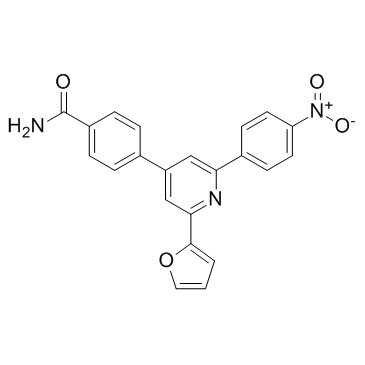| Description |
KJ Pyr 9 is an inhibitor of MYC with a Kd of 6.5 nM in in vitro assay.
|
| Related Catalog |
|
| Target |
Kd: 6.5±1.0 nM (MYC)[1]
|
| In Vitro |
KJ Pyr 9 (KJ-Pyr-9) interferes with MYC-MAX complex formation in the cell, as shown in a protein fragment complementation assay. KJ Pyr 9 specifically inhibits MYC-induced oncogenic transformation in cell culture; it has no or only weak effects on the oncogenic activity of several unrelated oncoproteins. KJ Pyr 9 preferentially interferes with the proliferation of MYC-overexpressing human and avian cells and specifically reduces the MYC-driven transcriptional signature. KJ Pyr 9 against three cell lines is tested known to be dependent on increased MYC activity: NCI-H460, MDA-MB-231, and SUM-159PT. The proliferation of all cell lines tested is inhibited, with IC50 values between 5 and 10 μM. Additionally, the proliferation of Burkitt lymphoma cell lines, which show constitutively high expression of c-MYC, is more sensitive to KJ Pyr 9 (IC50 values between 1 and 2.5 μM)[1].
|
| In Vivo |
To test the in vivo effectiveness of KJ Pyr 9 (KJ-Pyr-9), nude mice receive a xenograft of MDA-MB-231 cells suspended in Matrigel and injected s.c. into the left and right flanks. When the tumors have reached an average volume of 100 mm3, mice are treated daily with 10 mg/kg KJ Pyr 9 or vehicle control by i.p. injection for 31 d. Inhibition of tumor growth by KJ Pyr 9 is noted after 8 d of treatment. By day 31, the tumor volume in the KJ Pyr 9-treated animals has not increased significantly. At the conclusion of the experiment the tumors are extracted and weighed. The weight measurements are in agreement with the volume determinations and confirmed the ability of KJ Pyr 9 to halt tumor growth[1].
|
| Cell Assay |
Assays used staining with the redox dye resazurin to measure cell viability. Cells are seeded at 103 per 100 μL well in 96-well plates and grown in the presence of 2.5% FBS. MDA-MB-231 cells are cultured in DMEM; SUM-159PT cells are cultured in HAM’s F12; and NCI-H460 cells are cultured in RPMI-1640. MDA-MB-231 cells are exposed to KJ Pyr 9 (KJ-Pyr-9) for 216 h with fresh compound-containing medium supplied at 120 and 192 h; SUM-159PT cells are exposed to the compound for 120 h and fresh medium with the appropriate compound concentrations is supplied at 48 h; and NCI-H460 cells are grown with compound for 72 h. Triplicate cultures of P493-6 cells are grown in six-well plates from a starting density of 1×105 cells per mL in 4 mL culture medium per well. Compounds are added immediately following cell seeding. Following compound addition, cells are distributed by vortexing the plate at 400 rpm for 10 s. One hundred-microliter samples are taken after vortexing and counted using a Beckman Coulter Z1 counter at 0, 12, 24, 36, 48, 60, 72, and 96 h of incubation[1].
|
| Animal Admin |
Mice[1] Ten 8-wk-old female nude mice (HSD:athymic nude-Foxn1nu) are injected with 5×106 MDA-MB-231 cells s.c. into the left and right flanks. Cells are suspended in high-concentration Matrigel before injection. Xenograft tumors are allowed to grow until the average volume of the tumors reached 100 mm3, as measured by external calipers. At this point, the mice are divided into two groups. One receive 10 mg/kg KJ Pyr 9 and the other receive vehicle only, dosed daily by i.p. injection. Tumor volume and mouse weight are measured daily. Vehicle used in all cases is 10:10:80 Tween 80:DMSO:5% dextrose in water. The mice are treated for a period of 31 d. At the end of the experiment, the mice are euthanized and tumors are excised. Tumors are weighed. Samples of each tumor are fixed in formalin for histology and frozen for Western blotting.
|
| References |
[1]. Hart JR, et al. Inhibitor of MYC identified in a Kr?hnke pyridine library. Proc Natl Acad Sci U S A. 2014 Aug 26;111(34):12556-61.
|
